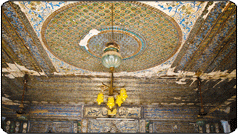Sheeshe Wali Masjid
Khalil Gibran, the philosopher and prophet of spiritual purity in thought acclaimed 'beauty' as 'eternity gazing at itself in a mirror'. A small mosque at Udai gunj in Lucknow known as 'Sheeshe wali Masjid' (glass work mosque) is an exquisite example of rare craftsmanship in its ornamentation and beautiful calligraphy. On entering the plain looking mosque one is bewildered at the mirror and glass-work which is not just beautiful but has the gift of presenting eternal thought in inscriptional form through calligraphy produced from specially cut coloured glass pieces. The calligraphy mainly presents verses from the Holy Quran.
Somehow, it is a pity that this unique and glorious specimen of artistic excellence has missed being featured in tourist manuals and literature covering the city of Lucknow, which is better known for its Imambara and Residency. There could be many reasons for this lapse.
Firstly, the mosque is barely more than half a century old. Secondly, it is a part of a private Trust and even though apparently there are no restrictions, the mosque has few visitors except the regular devotees that come to offer namaaz five times a day. Another reason is the location of the mosque itself. It is situated on the Cantt. (cantonment) Road [going from Hussaingunj crossing to Sadar] inside a compound, the arched gate of which opens on the road. The mosque is not directly visible from the road but even when it is visible, immediately after entering the compound, it appears quite insignificant on account of the short stature and plain looks. It goes unnoticed as any other common mosque, the type of which may be seen in almost every nook and corner of the city.
It is only when one goes inside the mosque that he is struck by the colourful and dazzling ornamentation of the interiors which cast a magical spell and put the visitor into a trance. The ornamentation can be seen in the prayer hall and the adjoining inner chamber. However, the fact is that the ornamentation is more dense and tastefully executed in the prayer hall.
Despite its being a small structure of about 8x8 metres floor area with a low ceiling, the floral and geometric patterns and the calligraphic inscriptions nowhere appear to be over or under-sized. Iranian craftsmen, famous the world over, for their traditional beautification and arabesque in architecture, were said to be employed to execute this ornamentation of the interiors of Sheeshe wali Masjid. They are believed to have been real brothers who were then in India on a commission for ornamentation of some palaces in Rajasthan and decoration of houses of some businessmen of Bombay.
The mosque was built by Haji Abdul Razzaq in the early thirties of this century, without the ornamentation work. He was the only son of Jar Mohammed, who was initially a military contractor foi supply and transportation of ice through railways foi almost all the military establishments in northern india. Jan Mohammed was able to set up a firm 'Jan & Sons' through the influence of his father Jahangir Bakhsh who served the British Indian Army in the last quarter of the 19th century. He was the distinguished recipient of the Victoria Cross, the highest honour that a.native serving the British army could be awarded. He retired holding the rank of Colonel in the army. In 1904, Jan Mohammed ventured into hotel business by establishing the Grand Hotel at the hill station in Naini Tal, which also served as the summer capital for UP. (then known as United °rovinces of Agra & Oudh). In 1906 he established the reputed Burlington Hotel at Lucknow, which still exists. Success in the setting up of these Western style hotels prompted him to establish four more hotels at Banaras (Varanasi), Kanpur and Agra. On his death in 1910, his son Abdul Razzaq inherited his flourishing business and continued to prosper thereafter. It was around 1930, that Abdul Razzaq (now a Haji after having performed his pilgrimage to Mecca) decided to build a small mosque as his grateful offering to God bestowing upon him good fortune and prosperity. Later, by chance he came in contact with the Iranian master-craftsmen and being highly impressed by their matchless art and skill decided to get the interiors of his mosque decorated in glass-work by them. When he learnt that they were also Ustad-e-Khattati(master calligraphers), he decided to have the best of calligraphic inscriptions executed by them in glass for the mosque's interiors.
It took about six years for the ornamentation and calligraphic inscriptions in glass to complete, around 1937. A lakh of rupees are said to have been spent on the mosque in those days, nearly 80% of which was spent on the ornamentation. This excludes the board and lodging expenses incurred upon the stay of the craftsmen and their assistants who remained the guests of Abdul Razzaq during the long period of execution of the ornamental work.
Haji Abdul Razzaq expired at the age of 80 years at Lucknow in1965 and according to his wish, his mortal remains lie buried close to the entrance of the mosque that was so dear to him. Haji Abdul Razzaq was a simple and modest man and his grave is bereft of any decoration and grandeur and is quite plain and simple, just the way he desired.
Iran is considered to be the most developed nation as far as the Islamic art of calligraphy and arabesque is concerned. One of its master calligraphers Mir Ali of Tabrez is credited with the invention of the distinguished calligraphic style of Nastaliq, which is now mostly used as a script for Urdu, besides Persian. In the Sheeshe wali Masjid, on entering the mosque, one will find on either side of it, Persian couplets in Nastaliq, which eulogise God and his messengers.
Al-Quran the holy book of Muslims is in Arabic and its verses are usually copied in one of its modified style (khat) of inscription called Naskh. Verses of the Quran abound all over the prayer hall of Sheeshe wali Masjid, and can be seen on the walls, panellings, borders of the ceiling and the insides of three pillars on their upper half having a square section. All these inscriptions have been done with glass pieces in different shades of blue.
In the Taj Mahal at Agra and other buildings like the Karbala Dayanat-ud-Daulah at Lucknow, one will find Quranic verses inscribed in the Thuluth (pronounced Salas) style on the exterior. The discerning visitor to the Sheeshe wali Masjid will find Quranic verses inscribed in this style of Thuluth as well. It has also been adopted for the 99 glorifying titles attributed to God, the Almighty, that appear in small octagonal spaces that adorn the outer edges of the ceiling. Inscription of holy names may also be seen on the archways and pillars connecting the doorway on the western side where again the Thuluth style has been adopted in the glass work. Unfortunately, due to negligence, on the part of the visitors and devotees coming to the mosque for prayers, the glass-work ornamentation and calligraphic inscriptions on the lower parts of the pillars on the west has mostly eroded and the surface denuded. Whitewashed plaster patches have taken their place which have spoilt the beauty and appear a blemish over the otherwise elegant atmosphere.
Somehow, most of the ornamentation in the intermediate pillars is intact. The lower parts of these intermediate pillars give the appearance of large flower vases. They have green, orange, brown and silver glass pieces stuck on their surfaces that form stripes of floral and geometric designs. Each set of pillars has a different design in which the stripes proceed, either horizontally, laterally or vertically.
The most impressive part of ornamentation in this mosque is visible in the ceiling of the prayer hall. The uniform ornamentation extends to a large area with mirrored mosaic work which covers nearly two-thirds of the ceiling area in a circular fashion. In this the tiny mirror pieces are so stuck that light falling on their surface is diffused and no complete image is formed. The arrangement has been specially employed so that a devotee offering prayers in the mosque is not distracted by the movements of others in the mosque. The glittering of these mirror pieces presents the spectacle of the sparkling of thousands of pearls studded close together.The corners of the ceiling have Meenakaari patterns akin to the type found in Taj Mahal at Agra and Deewan-e-Aam in the Red fort at Delhi, where they have been done by inlaying precious stones. But, here coloured blue, yellow and green glass pieces have replaced the precious stones. The ceiling also has seven calligraphic stripes that run parallel on all four sides. Each line of the calligraphic strip is separated with a strip of geometric pattern formed by coloured glass and mirror pieces that have been cut to triangular, diamond or rectangular shape. The ceiling is also bordered with 99 octagonal spacings that contain the glorific titles attributed to God, mentioned earlier.
The management of the Sheeshe wali Masjid is under a Trust formed by Mrs. Zahida Begum, the widow of Haji Abdul Razzaq in 1966. Due to financial constraints the Trust at best can maintain the mosque as an ordinary building. It does not have any special fund, provision or grant to take up the necessary repair and restoration work for the rare cultural and artistic inheritance with which it has been endowed. The devotees that come to the mosque, eventhough conscious of its beauty, are ironically not sensitive about its preservation and avoidance of further damage to the ornamentation. At many places the chippings and removal of glass pieces has been caused by neglect while cleaning and brushing by human touch [contact with the shoulders, elbows, and other parts of the body]. Damage to the delicate ornamentation has also taken place due to vibrations and knocking on the roof and other parts of the structure while fixing hangings such as chandeliers, lamps and fans.
It is feared that the beautiful calligraphy and ornamentation work in glass which is hardly 54 years old will not survive more than a decade or two and much of it will vanish in the absence of proper upkeep and periodical restoration that is urgently needed for the delicate glass-work.
Immediate attention of the government and other agencies like the INTACH and Indian Conservation Institute is forthwith required to take up this work. Also, the tourism department and its agencies need to discover this mosque - probably the only one of its kind in India because of the glass-work calligraphy - to attract more tourists to visit this unique 'Sheeshe wali Masjid' at Lucknow.
Source:
Pioneer, magazine
Sunday 27.10.1991 — Craving for limelight

